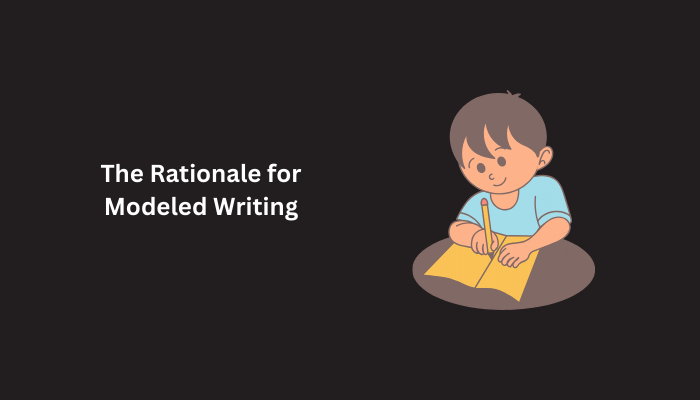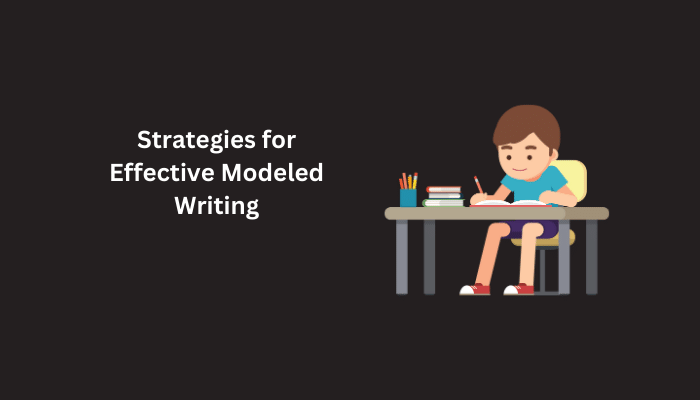Does it ever happen to you that you have a brilliant story in mind but you can’t decide how to begin it? Or you have written a beautiful narrative, but you are struggling with the end. Well, it is a common thing to happen to anyone. The same thing is faced by young writers as well.
They might have a creative idea but putting it into words is a different game altogether.
Here comes the role of educators and mentors who need to walk young learners through the process of writing. One of the efficient ways of doing so is Modeled Writing.
It is a powerful instructional approach that plays a pivotal role in developing students’ writing skills. In this comprehensive guide, let’s explore the various facets of this concept, its rationale, implementation strategies, and the critical role teachers play in this process.
If you are ready to adapt to this teaching method, let’s first understand what is Modeled Writing.
What is Modelled Writing and its Importance?
Modelled writing refers to the teacher's clear display of the writing process. It acts as a framework for learners, helping them to observe and learn good writing techniques. It helps students become competent writers by demonstrating the mental processes, decision-making, and skills involved in writing.
Modelled writing within the Gradual Release of Responsibility Model
Modelled writing is classified as the "I do, you watch" phase in the Gradual Release of Responsibility (GRR) structure. During this stage, the teacher takes the initiative by demonstrating writing concepts and approaches. This includes decisions about word choice, sentence structure, and organization, providing a clear example for students to follow. As students observe, they develop insight into the writing process, progressing from passive observers to active participants.
It is necessary to follow this during early writing lessons as the students might feel overwhelmed by the activity of writing. When they see someone doing the same task, making mistakes and improving the narrative along the way, it will take the load of writing the best thing in the first go, off their shoulders.
What is the difference between Modeled, Shared, and Guided Writing?
Modeled writing differs from shared and guided writing in terms of teacher engagement. In modeled writing, the teacher is the principal author, whereas in shared and guided writing, students progressively engage and take responsibility for the writing process.
The Rationale for Modeled Writing

One might think what is the rationale behind using this method of teaching as students are not involved in writing from the first go? Well, it is how this teaching method is incorporated into your writing lessons.
In crafting this sessions, educators can customize their approach to match specific genres, teaching cycles, or curriculum demands, thereby effectively illustrating pertinent strategies and techniques tailored to each instructional context.
Through this writing, students are prompted to engage in metacognition, or thinking about their thinking, and to refine their writing strategies, fostering autonomy and self-reliance in their writing venture.
The integration of 'think aloud' protocols within this concept is paramount, as educators articulate their cognitive processes aloud, making their thinking transparent to students. This transparency aids students in comprehending the rationale underpinning writing choices.
Furthermore, it not only enhances writing proficiencies but also enriches reading comprehension. Students acquire the ability to deconstruct texts and grasp the nuances of the writer's craft, skills that can be seamlessly applied to their reading practices, improving both reading and writing skills.
Now that we have established that writing can be an effective teaching method for writing skills, let’s take a look at how to implement this model.
Recommended Article: 7 Steps To Writing Successful
Implementing Modelled Writing
To implement this into your writing lessons, certain things need to be kept in mind. Here is a list of the things you need to be careful about while making your lesson plan.
-
Criteria for successful sessions: Effective sessions are strategic, focused, and tailored as per studnets’ development level. The sessions should have a clear objective and appropriate complexity that keeps the students engaged but doesn’t feel redundant. Younger students might focus on sentence structure, while older students would want to work on more complex narrative or persuasive texts.
-
Incorporating various elements: Good incorporates a number of components, such as planning through oral rehearsals, taking the needs of the audience into account, and modifying the tone to fit the goal of the writing.
-
Addressing misconceptions and enabling automatic use of basic skills: Teachers must ensure that over time, the students get more accommodated to using basic skills like punctuation and spelling. They should also address the misconceptions that students might have about writing.
Let’s take a deeper look at the strategies that can be used for effective for this means.
Strategies for Effective Modelled Writing

An important aspect of incorporating this strategies into your lesson plans, it is necessary to know the processes, utilize them to the best, and expand them so the students can learn other things as well.
-
Modeling Writing Processes: The main processes that you need to model during your lessons are planning, drafting, revising, and editing. These processes can provide a comprehensive view of how writing develops.
-
Utilize the ‘think aloud’ strategy: This is one of the most essential strategies to articulate the reasoning behind writing decisions. It helps students understand the choices writers make and how they can start working on the same.
-
Expand your process for descriptive language: Improve writing by using vivid adjectives and precise nouns in your rich noun phrases. These techniques enrich sentences with richness and color, drawing readers in with evocative language.
-
Incorporating grammar, punctuation, and spelling: Spelling, grammar, and punctuation should be naturally included in this sessions to show how they improve writing's readability and efficacy.
Now that we’ve established the strategies and implementation of this concept, let’s dive deeper into the role of teachers.
Teachers’ Role in Modelled Writing
In this, the teacher plays a pivotal role in guiding students through the writing process. They demonstrate writing in real-time, providing a live example without seeking direct input from students, allowing learners to observe the application of various writing strategies firsthand.
Moreover, the teacher explains the purpose behind the modeling session and the strategies employed, ensuring students understand the rationale behind each writing decision.
While maintaining control of the session, the teacher also encourages students to apply the demonstrated techniques in their writing, fostering independence and confidence.
Additionally, deliberate errors are strategically introduced as teaching opportunities, giving the instructor the chance to address typical difficulties and offer insightful commentary on the writing process.
The teacher's role in this is multifaceted, including demonstration, explanation, encouragement, and strategic error correction to help in effective learning and application of writing skills.
Now that we are clear about the role of teachers, let’s look into the role of students in modeled learning.
Students’ Role in Modeled Learning
In this concept, the student's role is primarily that of an observer and learner. Students are expected to attentively watch the teacher's writing process and the decision-making that goes into it.
It allows students to see firsthand how an experienced writer navigates the complexities of writing. They learn to recognize effective strategies that they can later apply to their writing endeavors.
Students are further encouraged to engage with the content which means taking notes on strategies that suit them and asking questions to clarify any uncertainties.
The learning doesn't stop when the session ends. Students are expected to participate in post-session discussions and activities that reinforce the strategies demonstrated. This could involve practicing a particular writing technique or reflecting on how they might use what they've learned in their writing projects. The goal is for them to internalize the observed strategies, making them part of their writing process.
What comes next is how to leverage the post-modeling sessions to encourage independent writing in students so they can improve their skills and move forward with the writing process.
Encouraging Independent Writing Post Modeling
After a modeled writing session, it is crucial to encourage students to engage in independent writing. What you need to keep in mind here is that initially, their stories would be similar to the samples you used and will gradually move towards being more original.
The transition from modeled writing to independent writing of new and fresh content requires a careful balance between providing a framework and allowing opportunities for independent practice.
Scaffolding can take various forms, such as providing writing prompts or graphic organizers, but it should gradually decrease as students gain confidence in their writing abilities. You can introduce different texts and genres to maintain students' independence and creativity.
This variety ensures that students are not overly reliant on a single model or style but can adapt their writing to different contexts and purposes.
Moreover, the importance of showcasing the writer's process does not end with the modeled writing session. Teachers should continue to highlight the value of planning, drafting, revising, and editing in their own writing and encourage students to incorporate these steps into their independent writing.
This continuous emphasis helps students internalize the writing process as a natural and essential part of creating a polished piece of work. It will also help in cultivating a strategic writing mindset in young writers.
Cultivating a Strategic Writing Mindset
Modeled writing helps in cultivating a strategic writing mindset among students. To help students write with greater purpose and strategy, teachers should support their development of an internal dialogue.
Thinking critically about the goal of their writing, the needs of their audience, and the best approaches to organize and present their ideas are all part of this internal dialogue.
Another important part of creating this mindset is addressing misconceptions about the natural progression of writing skills. Students may believe that writing ability is inherent or it should develop effortlessly.
Teachers can use modeled writing to demonstrate that writing is a skill that requires practice, reflection, and a willingness to revise and improve.
The impact of modeled writing as opposed to direct instructions on the writing process, is more nuanced and contextualized. It allows students to see how abstract writing concepts are applied in real-world situations, enhancing their learning and application of writing skills.
Conclusion
It is a multifaceted teaching strategy that offers numerous benefits for both teachers and students. It provides a clear, visible example of the writing process, encourages metacognition, and supports the development of independent writing skills.
By carefully implementing modeled writing in the classroom, teachers can help students become more competent, reflective, and strategic writers, equipped with the skills to navigate the complexities of written communication effectively.
Although modeled writing can be adapted to be practiced at home, it might pose certain challenges in terms of incorporating all of its aspects. If you want your child to learn the skill of writing with a flair, FunFox provides various resources and activities to make learning fun and interesting for students. Join our Writers Club now to explore more.





















